Graphics Reference
In-Depth Information
THE TEXTURAL COLLAGE
of changing typefaces and sizes echoes the graffiti on the wall in the
photograph.
Barbara Ferguson
United States
Formal Congruence
Similarities between type elements and pictorial elements make
a strong connection between the two. Every image portrays clear relationships between
figure and ground, light and dark, and has movement within it. Objects depicted in pho-
tographs have a scale relationship with each other and proportional relationships with
the edge of the image. When typographic configurations display similar attributes to
an adjacent image, or expand on those attributes, the type and the image are said to be
formally congruent. There are an unlimited number of ways for type to become congru-
ent with an image. The selection of a particular face for the type might relate to tonal or
textural qualities in the image. Instances in which type extrapolates the formal qualities
in an image create powerful emotional and intellectual responses in the viewer. Type
that is adjacent to an image also can be formally congruent in terms of its position re-
lative to the image. In this kind of formal congruence, the image exerts an influence
on the composition of the page as a whole. Even if the type retains its natural archi-
tecture, it may still react to the compositional architecture within the image. All three


